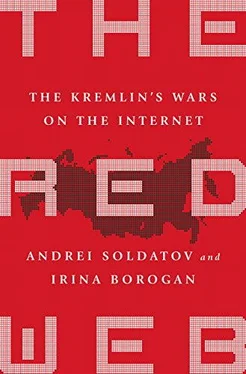After the meeting Levova hastened back to her office and immediately started to search for technologies that could block pages instead of sites. The answer she found enraged her. The only choice, it appeared, was “deep packet inspection,” a very intrusive technology, which allows an outsider to filter Internet traffic but also gives that outsider a way to penetrate into the content and effectively conduct surveillance.
Most digital inspection tools only look at the “headers” on a packet of data—where it’s going and where it came from. Deep packet inspection, or DPI, allows network providers to peer into the digital packets’ message or transmission over a network. “You open the envelope, not just read the address on a letter,” said an engineer dealing with DPI. It allows ISPs not only to monitor the traffic but also to filter it, suppressing particular services or content.
In late August 2012 the Russian government’s Ministry of Communications, along with some of the Russian Internet companies, concluded that the only way to implement the blacklist was through DPI. “As an example, they spoke of YouTube, to be sure that the particular video could be blocked, instead of the entire YouTube service. And they agreed on this mechanism. It was DPI,” Ilya Ponomarev, a member of the State Duma who enthusiastically supported the introduction of the blacklist, told us. [19] Ilya Ponomarev, interview with authors, September 2012. See also Agentura.ru, September 26, 2012, http://agentura.ru/projects/identification/iponomarev .
DPI drew concern from leading privacy groups over how governments would use this highly intrusive technology. Eric King, head of research at Privacy International, the leading British nongovernmental organization in the area of privacy, declared, “DPI allows the state to peer into everyone’s internet traffic and read, copy or even modify e-mails and web pages: We now know that such techniques were deployed in pre-revolutionary Tunisia. It can also compromise critical circumvention tools, tools that help citizens evade authoritarian internet controls in countries like Iran and China.” [20] Andrei Soldatov and Irina Borogan, “The Kremlin’s New Internet Surveillance Plan Goes Live Today,” Wired.com, November 1, 2012, www.wired.com/2012/11/russia-surveillance .
The system in Russia was tested in September, even before its official launch in November. Several prosecutors requested that access to a controversial video, “Innocence of Muslims,” be blocked in different Russian regions. [21] The video was considered insulting to Muslims and includes cartoonish scenes depicting the prophet as a buffoon, a womanizer, and a greedy thug, among other things.
On September 27 the three largest mobile and Internet service providers—MTS, VimpelCom, and MegaFon—restricted access to the inflammatory video. VimpelCom blocked access to websites that posted the video, which made YouTube as a whole inaccessible in seven Russian regions. [22] YouTube was made inaccessible in Chechnya, Dagestan, Kabardino-Balkaria, Ingushetia, Karachay-Cherkessia, North Ossetia, and the Stavropol Region.
But MTS and MegaFon succeeded in blocking access just to the video itself thanks to DPI that had been already installed on their systems.
For a number of years the ground had been carefully prepared to reach this point. For commercial reasons, DPI technology had been introduced in Russia in the mid-2000s. It was needed then to control torrents—streams of data often used by pirate file-sharing—which can hog all available bandwidth. DPI technology helped mobile operators in Russia resist those users who would take up so much bandwidth. In a few years all the biggest DPI technology vendors had a presence in Russia: Canada’s Sandvine, Israel’s Allot, America’s Cisco and Procera, and China’s Huawei. By the summer of 2012 all three national mobile operators in Russia had DPI at their disposal: Procera was installed by VimpelCom, Huawei’s DPI solutions are in use in MegaFon, and MTS bought Cisco technology. [23] For details, see Soldatov and Borogan, “The Kremlin’s New Internet Surveillance Plan Goes Live Today.” The mobile operators in Russia came up with the idea of traffic “shaping,” a euphemism that means by using DPI technology, they could, if they wished, suppress particular services—in most cases torrents, peer-to-peer protocols, and Skype, which poses a threat to the voice-over Internet protocol services offered by the mobile operators themselves.
At the same time, the Russian authorities didn’t miss the remarkable capabilities DPI would open up for surveillance. On September 27 Russia’s largest information security conference, held at the international exhibition center Krokus Expo, featured a panel on “SORM in the Environment of Convergence.” The talk was intended for professionals, and the room was filled with the chiefs of SORM departments at mobile operators and the Moscow city phone network as well as representatives from surveillance equipment manufacturers. DPI quickly emerged as one of the hottest topics of the discussion. Many in the room seemed certain that the only way to guarantee legal interception in the new era of cloud computing and communications was DPI technology.
However, there was a legal issue. DPI devices are manned by the employees of the Internet providers or mobile operators—private companies. But the SORM boxes are at the full disposal of the FSB. Still, the idea of connecting SORM with the operators’ DPI seemed not to bother anybody in the room. [24] See details of the meeting in our investigation: Soldatov and Borogan, “The Kremlin’s New Internet Surveillance Plan Goes Live Today.”
Television remained a battleground over the protests. The government’s channels bombarded audiences with special programs attacking the opposition. Several of them were titled, in serial, “Anatomy of the Protest.” One, aired in October 2012, accused one of the leaders of the opposition, Sergei Udaltsov, of preparing a coup d’état. Udaltsov’s apartment was searched, and a criminal prosecution was launched against him.
But television brought a new approach to the opposition as well. Back in June the protests’ organizers had promised to create a council of the opposition that would represent all political forces opposed to Putin and would be a vehicle for carrying out discussions with the Kremlin. On September 21 Leonid Volkov, Navalny’s chief lieutenant, and Yuri Saprykin, both deeply involved in the protest activities, paid a visit to Mikhail Zygar, the editor of TV Dozhd. The council was to be selected by democratic means—an election—on October 20–22. Volkov and Saprykin suggested organizing a series of debates on TV Dozhd—online and uncensored.
Zygar was struck by the idea. “We didn’t have then the feeling of danger, we thought we need to respond to the expectations of people,” he recalled. He worried whether it would at all compromise the television channel’s principles and whether it would be seen as propaganda for a political force. But he answered his own questions by saying there were so many different people from so many different forces that it would be impossible to be captured by any one of them. The opposition ran from liberals to nationalists. Zygar decided they would broadcast the debate at midnight, far from prime time, so only really committed people would watch it. The debate project came together very quickly—in a day or two. [25] Volkov and Saprykin had come to see Zygar at noon, and by 3:00 p.m., Zygar secured approval from Sindeeva, and by 11:00 p.m. of the same day, Zygar, Volkov, and Saprykin sat at the café on Nikitskaya Street to talk over the technicalities. They also invited Demian Kudryavtsev, a former CEO of Kommersant publishing house; Zygar intended to ask him to cohost the debate along with Saprykin. Kudryavtsev eagerly supported the idea.
Читать дальше












